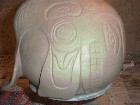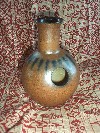|
Making "One-of-a-Kind" Udus and Other Custom Handmade Clay Drums and Instruments |
|
|
|
Clay Beats specializes in producing custom hand-made
clay Udu drums.
Other styles of ceramic drums, rattles, and other instruments may be seen in the
gallery...
Drums with custom designs are available upon request, but require a cash
deposit.
Drums may also be ported to facilitate a mike for live applications upon request.
I may also consider a trade, exchanges, or barters depending on what you have to
offer.
Email me if you perfer this to a cash exchange.
What is an Udu?
An Udu, is a clay pot drum based on those
created by the Ibo and Hausa tribes in Nigeria, and means "pot" in the Ibo
language. This drum came about when some ancient village potters struck a second
opening, a side hole, in a clay water vessel and discovered the beautiful sound it
produced. This became the side-hole pot drum. The deep, haunting tones it produced were
thought by many to be the "voices of the ancestors." They were initially used in
religious and cultural ceremonies. A type of 'pot' drum is also played in India,
too, but has a totally different design.
Udu drums are not only beautiful to look at due to their stylish designs and form,
but are sought by musicians, both professional and casual, because of their unique sound
which can vary from deep bass tones, tabla-like qualities, the tonal variations of the
African talking drum, and many other sounds. This makes the Udu well-suited to melodic as
well as rhythmic articulations.
The basic playing technique includes, but is not limited to, playing with the palm
of the hand on the side hole while opening and closing the top hole in varying degrees
with the other hand, and vice versa. One can also alternate a beat by slapping each
hole in sequence. By varying the type of stroke and the way in which you release your
hand, you can coax many different tonal variations from the instrument. You can also
strike any part of the drum with your fingers or slap it to produce higher tones.
The drums made by Clay Beats vary from serveral types
of professional models to the smaller more personal style of drums. The firing
methods used vary from open pit firings, salt kiln firing, and common glazed kiln firings.


